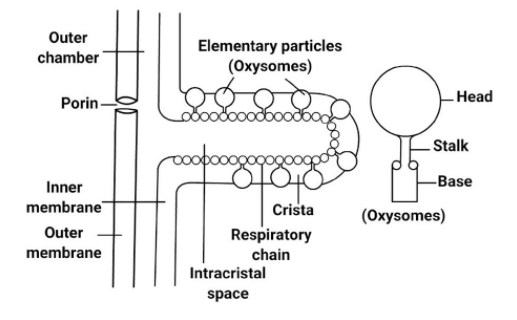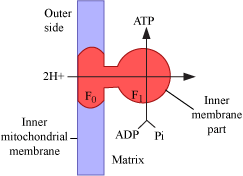Mitochondria | Cell OrganelleMitochondria (singular: mitochondrion) are double-membrane bound cell organelles like chloroplast and nucleus. They are mostly found in eukaryotic cells and referred to as the 'powerhouse of the cell' as they produce ATP (Adenosine Triphosphate) through cellular respiration. ATP is an energy molecule or source of energy that provides energy to the cell to perform various biochemical reactions. Mitochondria were discovered by Kolliker in the flight muscles of insects. The term 'Mitochondria' was given by Benda. Mitochondria and chloroplast (present in plant cells) are the only organelles that contain their own DNA. Furthermore, mitochondria can replicate as they have their own DNA (genetic material) and ribosomes to build proteins. Due to its ability to replicate, it is also known as a semiautonomous body. Number of mitochondria:The number of mitochondria varies from cell to cell depending on the activities of a cell. If a cell is more active, it will have more number of mitochondria. For example, the cells in the flight muscle of insects may contain up to 5lakh mitochondria and its number can be up to 50000 in giant amoeba. However, some unicellular organisms like Chlamydomonas and chlorella contain only one mitochondrion. Structure of mitochondria:It is generally a disc or oval-shaped organelle, which is enclosed by a double membrane; inner mitochondrial membrane and outer mitochondrial membrane. The space between the theses membranes is called intermembrane space or outer compartment. Whereas, the space enclosed by the inner membrane is called the inner compartment. The inner surface of the inner membrane towards the matrix is called the M face. Whereas, its outer surface towards the outer space is called the C face or cytosol face. 
The outer membrane is porous and contains fewer proteins and is permeable in nature. The inner membrane is folded or has folds and it has more proteins and is semipermeable in nature. The folds of the inner membrane are called cristae (singular: crista). The material present in the inner compartment is called matrix and is pale yellow in colour due to the presence of riboflavin. The matrix contains enzymes that are required for cellular respiration. It is also rich in divalent ions like Mg2+ ions, Mn2+ ions, and Fe2+ ions. These ions act as activators for the enzymes that take part in cellular respiration. Besides this, circular DNA and ribosomes are also present in the matrix. It has 70S ribosomes, which is the same as that found in prokaryotes. What is oxysome?It is an important structure present in the mitochondria present on the surface of the inner membrane of the mitochondria. Oxysomes are also known as F0-F1 particles, or elementary particles. These structures help in the synthesis of ATP. Oxysomes are present on the inner membrane surface mainly on the crista. Structure of Oxysome:Oxysome has three parts, the bottom or base part is embedded in the membrane. It is known as the F0 particle. The second part extends from the base and it is a protein and is known as F5-F6 particle or the stock part. The third part is enlarged which is also a protein and is attached to the stock part. It is known as F1 particles or the head of the oxysome. 
The head part acts as ATPase so it helps in the synthesis of ATP due to this reason it is also known as ATP synthetase. The number of oxysome also varies, it can be 1000 to 100000 in a mitochondrion depending on the activity of the cell. How is ATP produced in the Mitochondria?The proteins in the inner membrane act as an electron transport chain. When the electrons move through this chain, a pair of protons (H+) is pumped from the matrix into the outer compartment. So, due to the high concentration of protons in outer space, the protons tend to move into the matrix. 
The high energy protons move through the oxysome. They enter from the base of the oxysome. When they arrive at the head of the oxysome, they use high energy of protons to add inorganic phosphate to ADP to form ATP. So, the energy needed to produce ATP is produced when protons move back into the matrix down their gradient from the intermembrane space. For every one pair of protons that move into the matrix through the oxysome one ATP is synthesized. The head itself acts as an enzyme. This is the reason, mitochondria are called the powerhouse of the cell and it is the oxysome where ATP is synthesized in the mitochondria. Thus, cellular respiration that occurs in Mitochondria converts glucose and oxygen to adenosine triphosphate (ATP) and produces energy. This energy is used by the cell, a cell cannot work without this energy. So, ATP is known as the biochemical energy 'currency' of the cell. Functions of Mitochondria
Next TopicLysosome
|
 For Videos Join Our Youtube Channel: Join Now
For Videos Join Our Youtube Channel: Join Now
Feedback
- Send your Feedback to [email protected]
Help Others, Please Share










